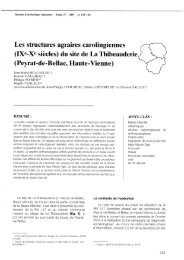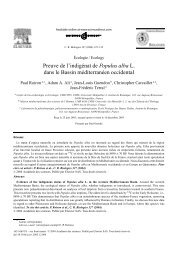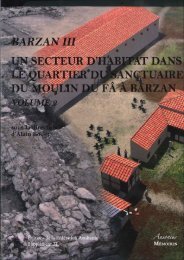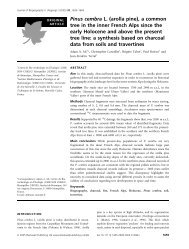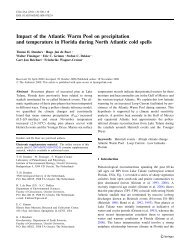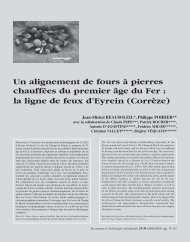The Egyptian olive (Olea europaea subsp ... - ResearchGate
The Egyptian olive (Olea europaea subsp ... - ResearchGate
The Egyptian olive (Olea europaea subsp ... - ResearchGate
You also want an ePaper? Increase the reach of your titles
YUMPU automatically turns print PDFs into web optimized ePapers that Google loves.
Claire Newton, Jean-Frédéric Terral & Sarah Ivorra<br />
Discussion<br />
<strong>The</strong> <strong>olive</strong> stones found on both the archaeological sites, in both the Persian and the Roman<br />
periods, are related to two distinct modern groups (Table 1). One group is represented by<br />
the modern <strong>Egyptian</strong> cultivars, which themselves form a distinct group from the rest of the<br />
reference material (Figure 2). This shows that there has been continuity in the cultivation<br />
of this group of cultivars from at least the middle of the last millennium BC. In the present<br />
state of research, this could mean that these cultivars evolved and were selected in Egypt,<br />
or that the cultivar that was first introduced in Egypt has not yet entered the reference<br />
data base. Genetic data from Toffahi has shown the presence of a specific marker (ME2<br />
mitotype) (Besnard & Bervillé 2000; Besnard et al. 2002) common in some cultivars such<br />
as Amygdalolia (Greece), Zaity (Syria), probably originated from an ancestral domestication<br />
centre located in the Eastern Mediterranean Basin. However, the origin of this group<br />
currently remains unknown.<br />
<strong>The</strong> second group is related to wild types and cultivars that could have originated in the<br />
Levant region (Syro-Palestine), the region where the oldest traces of intensive <strong>olive</strong> use and<br />
perhaps cultivation have so far been found (Liphschitz et al. 1991). This implies that <strong>olive</strong>s<br />
of this variety were perhaps first imported as fruit or oil into Egypt and later introduced as<br />
cultivars. Trade relations between the two regions are older than the Pharaonic period, and<br />
they have been under common rule several times during their history.<br />
<strong>The</strong> presence of <strong>olive</strong>s from both areas of origin during the Persian period raises the<br />
question of whether they were introduced at that time. Briant (1997: 89) suggests that the<br />
Persian authorities could have given fiscal incentive to <strong>Egyptian</strong> farmers to settle and dig<br />
qanâts (underground water-collecting galleries) in the region, leaving them free to arrange<br />
the details of the irrigation regulations. That could also have been the case for the selection<br />
of crops to grow on the irrigated land. <strong>The</strong> choices would thus be in accordance with local<br />
constraints rather than with a distant central power. However, <strong>olive</strong> remains are still scarce<br />
for this period at ’Ayn-Manâwir (fragments, 3 complete stones), although that may be due<br />
to the mode of preservation, i.e. exclusively charred. No mention is made of any <strong>olive</strong><br />
product or of <strong>olive</strong> cultivation on the Persian period ostraca (M. Chauveau pers. comm.),<br />
and up to now no <strong>olive</strong> charcoal has been identified.<br />
Between the Persian and Roman periods, there is evidence of occupation during the<br />
Ptolemaic period, but no <strong>olive</strong> remains were found in the few samples collected (Newton<br />
2002). However, it is possible that the trees introduced presumably under Persian rule were<br />
cultivated until the Roman time of expansion of the local settlements. Grafts and/or fruit<br />
from elsewhere could also have re-introduced oleiculture in the oasis. In the Roman period<br />
there is textual evidence for the presence of <strong>olive</strong> groves and <strong>olive</strong> oil in the area of the two<br />
sites examined (P. Jand. 142; Wagner 1987: 296). <strong>The</strong> cultivation of <strong>olive</strong> trees is described<br />
on field borders, and in association with barley, grapevine, and date palms (P. Jand. 142;<br />
Bousquet & Reddé 1994: 87-8).<br />
Although Persian-period <strong>olive</strong> stones are scarce, the results show that two different varieties<br />
were grown at that time, and that the same two were still grown five centuries later, during<br />
the Roman period. <strong>The</strong> more abundant Roman material also shows that one or several more<br />
varieties were produced at that time, but it cannot yet be demonstrated whether they were<br />
Method<br />
411




